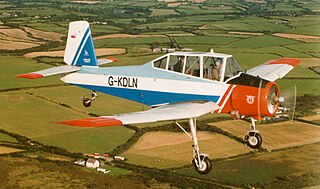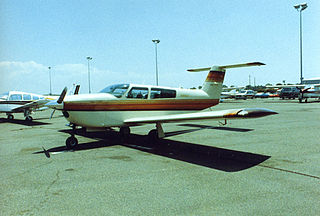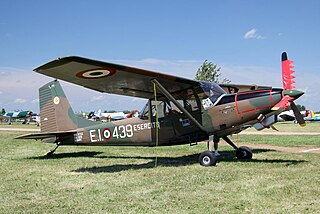
The Rutan VariEze is a composite, canard aircraft designed by Burt Rutan. It is a high-performance homebuilt aircraft, hundreds of which have been constructed. The design later evolved into the Long-EZ and other, larger cabin canard aircraft. The VariEze is notable for popularizing the canard configuration and moldless glass cloth composite construction for homebuilt aircraft.

The Rutan VariViggen is a homebuilt aircraft designed by Burt Rutan. The aircraft is a tandem two-seater of primarily wooden construction with a delta wing and a canard foreplane. The VariViggen is powered by a 150 hp Lycoming O-320 aero engine in pusher configuration. The prototype was designated Model 27, and the production version was Model 32.

The Harbin Y-11 is a high wing twin-engine piston utility and geological survey aircraft built by Harbin Aircraft Manufacturing Corporation (HAMC).

The Bellanca Viking and Super Viking are a series of single-engine, four-seat, high performance, retractable gear aircraft manufactured in the USA during the 1960s and 1970s. The aircraft developed through modifications of classic designs by the aviation pioneer Giuseppe Bellanca. A total of 1,356 Vikings have been produced with most production between 1968 and 1975.

The Saunders ST-27 was a regional aircraft built in the 1970s by the Canadian Saunders Aircraft Company based at Gimli, Manitoba. The aircraft was designed as a conversion of the earlier de Havilland Heron. The conversion program was extensive and featured two Pratt & Whitney Canada PT6 turboprops and a stretched fuselage. Despite its promise as a regional airliner, the project collapsed when Manitoba government funding was withdrawn in 1976.

The Aerosport Quail is an ultralight aircraft that was designed for home building by Harris Woods. First offered for sale in 1971, by the end of the decade, 375 sets of plans had been sold, with around 26 aircraft under construction and 10 flying.

The Zlin Z-37 Čmelák, also known as LET Z-37 Čmelák is an agricultural aircraft which was manufactured in Czechoslovakia. It is powered by a Soviet-built Ivchenko reciprocating engine. The aircraft is used mainly as a cropduster.

The PZL-105 Flaming (flamingo) is a Polish short-takeoff-and-landing (STOL) utility aircraft designed by PZL "Warszawa-Okęcie". It remained a prototype.

The Bellanca CH-400 Skyrocket is a six-seat utility aircraft built in the United States in the 1930s, a continuation of the design lineage that had started with the Bellanca WB-2. Retaining the same basic airframe of the preceding CH-200 and CH-300, the CH-400 was fitted with a more powerful Pratt & Whitney Wasp radial engine.

The Bellanca 31-40 Senior Pacemaker and its derivatives were a family of a six- and eight-seat utility aircraft built in the United States in the late 1930s. They were the final revision of the original late 1920s Wright-Bellanca WB-2 design. The model numbers used by Bellanca in this period reflected the wing area and engine horsepower, each divided by ten. Like their predecessors, these were high-wing braced monoplanes with conventional tailwheel undercarriage.

The Bellanca 14-7 Junior and its successors were a family of light aircraft manufactured in the United States by Bellanca Aircraft Corporation shortly before World War II. They were followed post-war by the Bellanca 14-13 and its derivatives.

The Bellanca T-250 Aries was a light airplane built in the United States in the early 1970s, which achieved only limited production. Designed by Marvin Greenwood in Texas while his company, Anderson-Greenwood, owned the Bellanca name, it was offered as a Bellanca product. It was a conventional low-wing monoplane with retractable tricycle undercarriage and a high T-tail. Federal Aviation Administration type certification was obtained on 28 July 1976.
The Davis DA-5, a.k.a. DA-5A, is a single-seat sport aircraft designed in the United States in the 1970s and marketed for homebuilding. Like designer Leeon D. Davis's successful DA-2, it is a low-wing monoplane with fixed tricycle undercarriage and a V-tail, but with a much narrower fuselage accommodating only the pilot, and a lengthened nose. Design work was carried out in 1972, but the prototype was not built until 1974, when it was completed in only 67 days.

The PZL-102 Kos (blackbird) is a Polish two-seat touring and training monoplane designed and built by PZL.

The SIAI-Marchetti SM.1019 is an Italian STOL liaison monoplane built by SIAI-Marchetti for the Italian Army. It is a turboprop-powered derivative of the Cessna O-1 Bird Dog.

The IAR-824 was a utility aircraft built in Romania in the 1970s.

The Jeffair Barracuda is a high-performance sporting monoplane that was developed in the United States in the 1970s and is marketed for homebuilding. Designed and built by Geoffrey Siers, the prototype won the prize for "Most Outstanding New Design" at the EAA Fly-in in 1976. It was a low-wing cantilever monoplane of wooden construction with retractable tricycle undercarriage and side-by-side seating for two. Around 150 sets of plans had sold by 1977.

The Il-54 was a transonic bomber developed in the USSR in the 1950s. Only two examples were built before the project was abandoned.

The Wassmer WA-80 Piranha is a French two-seat low-wing cabin monoplane trainer designed and built by Société Wassmer. Based on the same construction as the company's WA-50 four-seater, the WA-80 was a scaled down version. The prototype, registered F-WVKR, first flew in November 1975 powered by a 100 hp Rolls-Royce Continental O-200 engine. Wassmer appointed a receiver and suspended production in 1977 after 25 had been built.

The Scheibe Bergfalke is a German glider designed by Egon Scheibe as a post-World War II development of the Akaflieg München Mü13 produced before and during the war.



















